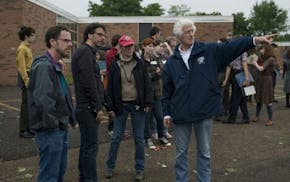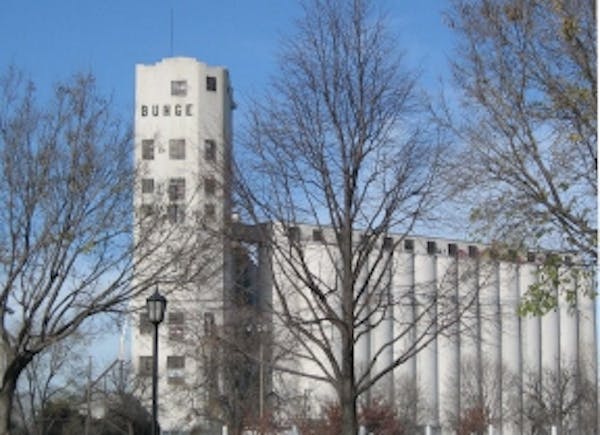A 100-foot plummet that ended in a face-first landing saved Luke Kutsch.
The 22-year-old took the fall during an after-dark trip to an abandoned grain elevator last month. In an impromptu foray, Kutsch, 22, climbed into the former Fruen Mill near his Bryn Mawr home with two friends.
He's still in the hospital and faces at least three more months of recovery from a broken femur and pelvis, and a jaw cracked in six places. But it could have been a lot worse — and he knows it.
"I'm very lucky to be alive," he said in his first interview since the accident. "I could have destroyed my spine or neck or brain."
Kutsch was taking part in what practitioners call urban exploring — entering and climbing around in abandoned buildings.
Although it's been done for decades, the pastime has taken a modern twist with social platforms such as Instagram and YouTube, where gadgets like GoPros and DSLR cameras are used to showcase the explorers' antics.
Although some urban explorers carry mountain climbing gear, Kutsch carried only a flashlight. He didn't even bring a phone on which he could call for help after he fell, which he now regrets.
"The thing is," he said, "we didn't expect to fall."
Kutsch's five-hour rescue is one of two recent incidents, one fatal, that have grabbed headlines but failed to deter other explorers, who find allure in abandonment and history in decay.
The Twin Cities have long been a prime spot for urban exploring, or "lurking," as one popular Instagram hashtag calls it. The area has lured thrill seekers, the curious, even squatters to slip into hulking industrial complexes, tunnels, caves, rail tracks, large drains and underground rivers. Explorers say they also pay afterhour visits to active factories or construction sites, such as the U.S. Bank Stadium in downtown Minneapolis.
"We don't have mountains to climb in Minnesota. We don't have white water rapids to go shoot. We have interesting abandoned buildings to be explored," said Paula Pentel, coordinator of the urban studies program at the University of Minnesota.
Pentel is not an advocate of urban exploring but understands its popularity.
"We sort of have this perfect storm in the Twin Cities — we have many universities and colleges, and young people located close to where these places are," she said.
Minneapolis generally doesn't demolish vacant sites that are structurally sound because of potential for redevelopment, said Mike Rumppe, the city's fire inspection coordinator.
"The point is that these are not public spaces that you and I could choose to go to and climb and rappel," he said. "This is private property."
Signs that forbid trespassing are posted on most frequently visited sites, Rumppe said, and city officials seal up and then monitor accessible, high-hazard sites when possible. But people often find ways around the barricades.
It's not just the climbers who are at risk, Rumppe added.
"Any time we have to perform a rescue of someone who has an accident or an incident in these properties, you're jeopardizing the lives of other rescuers and firefighters," he said. "These are not easy rescues."
There have been at least 11 incidents reported at city mills and elevators since 1979, although many more likely went unreported, officials say. The most recent fatality occurred at the Bunge grain elevator, located along 13th Avenue SE. in Minneapolis, where University of Minnesota student Emily Roland, 20, fell to her death in June. Kutsch's fall came three weeks later.
Kutsch didn't receive a ticket for trespassing, but his two companions did.
"I think [the police] knew I learned my lesson," he said.
Drawn by 'rebel-ness'
Jake Freese, who's been an urban explorer for about two years, posts snapshots of his adventures on Instagram @twincitiesjake a couple times a week.
"I like the rebel-ness of it. The fact that it is illegal and dangerous is what's fun about it, to be honest," said Freese, 22, who lives in Bloomington.
For another urban explorer — a 20-year-old man who asked to be unnamed — the activity has become a lifestyle. The Minnetonka native goes out nearly every other night with some friends, sometimes until 3 a.m.
"I guess you can see bits and pieces of history through decay," he said.
Getting caught isn't much of a deterrent, even though explorers could wind up with misdemeanor tickets for trespassing, punishable by a maximum of 90 days in jail or a $1,000 fine, said Minneapolis police spokesman John Elder. Burglary charges can apply if a trespasser damages a building.
Experienced explorers say they don't go alone, while intoxicated or without proper equipment, including headlamps. And while some have expressed concern that their photos glamorize a dangerous activity, they blame novices for being unprepared.
"They need to know their physical capabilities, what they can do and what they can't," Freese said. "I do feel bad for the kids who fell and get hurt, but I do have a little bit of anger toward them because this is what ruins it for the real urban explorers."
Growing older, wiser
Andrew Notsch, 27, said a sense of adventure propelled him into urban exploring. "I really, really appreciate doing stuff that most people aren't willing to do or try," he said.
He's conscious of the hobby's illegal nature, and said he visits fewer sites that would require trespassing than he did in his early 20s.
"I'm not 18 and just out of high school with nothing to lose," he said. "If I get into a situation, it's much bigger of a situation now."
Kutsch's outlook has also changed. He's in constant pain and has nightmares of the fall.
His parents, who live in Iowa, have taken shifts at his bedside at Hennepin County Medical Center.
"I feel really bad that I've had to put them through all of that," said Kutsch.
In retrospect, he realizes that his one-night thrill wasn't worth it. And that overconfidence in his urban exploring ability got the best of him.
"Just because you've done it before doesn't mean you can do it every time," he said.
Natalie Daher • 612-673-1775

This reporter didn't survive his audition for 'Survivor'
Spring's hot gift book features gorgeous found-nature photos

Jane Smiley hits again with 'Lucky' but what the what is that ending?

Biography details what 'Rulebreaker' Barbara Walters did to get to the top

